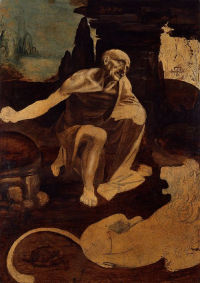The Body of Man Click on the thumbnails to explore the trail
Read more about this trail (expand)
According to Leonardo, man himself was at the centre of everything– “The measure of all things”. Throughout his life, the artist engaged in a dynamic and increasingly in-depth examination of man as a living organism, embarking on a seemingly unending quest to discover how man moved, grew, developed and perceived the world in which he lived.

- Enlarge
-
© Musei Vaticani, Rome
St Jerome praying in the Wilderness c1480
The challenge of representing the human form was a major preoccupation for Renaissance artists. They aspired to the qualities of classical art and sculpture and the representation of figures that lacked only a voice. Before Leonardo, Leon Battista Alberti had advised artists to study the human body and to build the figure in three stages - first the bones, then the nerves and muscles and finally the flesh and the skin.
The study of anatomy was fundamental to Leonardo’s activity as a painter. In order to portray the body correctly he sought to understand why it appeared as it did. In this unfinished painting of St. Jerome, who is shown chastising himself for his sins, the expressive anatomical detail of the head and body of the elderly saint is unprecedented.
But for Leonardo, an understanding of the individual parts of the body alone was not sufficient. He wanted to convey how all the various parts worked together as a coherent whole. The successful realization of the Saint’s complex kneeling pose in this painting is undoubtedly the result of extensive study from life and from sculptural models.
In Leonardo's words
It is a necessary thing for the painter, in order to be good at arranging the parts of the body in attitudes and gestures which can be represented in the nude, to know the anatomy of the sinews, bones and muscles and tendons.
This unfinished panel represents St. Jerome (AD 347-420), one of the four doctors of the Western Church, in a scene inspired by the fanciful account of the Saint’s later life given in Jacobus de Voragine’s Golden Legend. St Jerome lived in the desert for four years, with, in his own words, “only the scorpions and wild beasts for company”.
Leonardo portrays the very elderly Jerome, gaunt and almost toothless, kneeling in a rocky landscape in prayerful contemplation. In his right hand he holds a stone with which he beat his breast to chastise himself. In the foreground we see the lion that was said to have become Jerome’s faithful companion after the Saint removed a thorn from its paw. In the background on the right, through what appears to be an opening of a cave, a briefly sketched church façade has been included, which is another attribute of St. Jerome and a reference to his status as father of the Church. On the upper left Leonardo has freely sketched a mountain range enveloped in a hazy atmosphere, which is not unlike the landscape of the Virgin of the Rocks.
The body of St. Jerome is a testament to Leonardo’s study and knowledge of human anatomy and movement, and his ability to convey expression through bodily form. The lifelike appearance of St. Jerome’s lion indicates Leonardo’s knowledge of nature, probably gained through the study of real lions in drawings.
- Medium Oil and tempera on wood panel
- Size 102.8 x 73.5 cm
- Location Pinacoteca Vaticana












